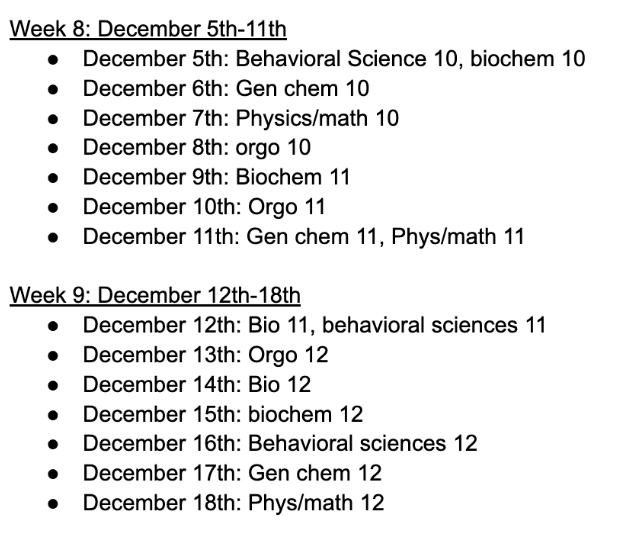If you’re faced with adding the MCAT to an already rigorous academic and extracurricular schedule, you might be more than a little stressed out. I certainly was. But there is really no need to fear!
Here is my story and recommendations for achieving a 520+ MCAT without sacrificing your GPA and extracurricular activities.
My story
It was Thanksgiving break, but it felt more like spooky season. I had signed up to take the MCAT and had no idea how I was going to succeed. Here is what I was facing:
- I hadn’t taken all the courses that covered what the MCAT would be testing.
- I was a double major in math and science preprofessional studies with a minor on top of that, so I couldn’t reduce my credit hours.
- I was captain of the Notre Dame club soccer team and was in charge of practices twice per week, games on the weekends, and raising $16,000 to send the team to the national championship tournament.
- I volunteered weekly at 2 clinics among other extracurriculars.
- I was part of a molecular biology research lab with its own set of commitments.
- On top of that, I had just come off a serious concussion that made focusing for long periods of time difficult.
What was I going to do? I had absolutely no time to spare!
Like many other premeds, I found myself extremely overwhelmed. So, I ended up doing what many stressed premeds do: I went on reddit and hoped a random person had the key to figuring out my life. I considered taking a gap year to study, dropping my extracurriculars, and even dropping one of my majors or minor.
After this initial period of panic, I came up with a study plan, and this plan was one of the best decisions I made in my premed journey. Below, I will outline my recommendations for creating a study schedule and some tips and tricks for taking the MCAT as a stressed premed student.
Tips & Tricks
Space things out
Doing just a little bit of studying every day is the best way to succeed and still have time for the other important things in your life. For example, I only did one chapter of review per day during the week, which was reading and taking notes on just a few pages. This allowed me to think to myself, “All I have to do is ______ today.” Once that was done, I could go to my soccer practices, volunteer, do my homework, and even relax every once in a while.
Create a checklist
Turning the MCAT into a series of 2-3 tasks to do per day makes the test seem a lot less scary. Additionally, checking off tasks each day was fulfilling and instilled confidence in myself.
Use anki
If you’re going to go to medical school, you might as well start studying like a med student. Anki is a favorite of medical students because it is a tool that automates learning. All you have to do is open the app and click on 5 different keys to have spaced repetition of all the material you need to know. If you don’t feel like making your own cards, download a deck online (the MilesDown deck is great and free)!
“Practice how you’re gonna play”
This is something sports coaches will regurgitate until the end of time, but it applies to studying too. If you treat practice exams like the real test, then taking the real test will feel like something you do on any given Sunday. That means not using your notes, taking the full time for breaks, applying the appropriate time constraints, etc.
Have fun
I look back on my time studying for the MCAT very fondly. There was something special and empowering about it. Every little tidbit of information you learn on a given day makes you one step closer to becoming a doctor. The little rewards you give yourself after completing a full-length practice exam or getting through all the content review are some of the most satisfying moments you can have as a student. Try your best to enjoy it through the ups and downs and don’t be too hard on yourself if you have an off day.
My personal study plan
From the time I signed up, I had 4 months to get my act together. Below is the schedule I made for myself. Keep in mind that every person is different and has different strategies that work best for them, so take my schedule with a grain of salt.
Phase 1 (weeks 1-8): content review
- Take a free half-length diagnostic exam (free via Blueprint and other 3rd party companies). See which content you need the most help on.
- Read and take notes on one chapter per day of Kaplan books on weekdays, and 2 per day on weekends.
- This is what a typical weekly schedule looked like:

Phase 2 (weeks 9-12): Repetition and practice
- Full-length practice exams: Take a full-length exam every Saturday morning from a 3rd party resource. Review all the questions that were incorrect.
- Daily Anki: Go through all your notes and highlight what does not come automatically to you. Turn your highlights into anki cards and do them daily. Calculate how many new cards per day you need to do to finish all new cards 1 week before your exam date.
- Daily Practice problems: Do as many 3rd party practice problems as you can manage without going insane.
Phase 3 (weeks 13-16): AAMC materials.
- Full-length practice exams: Take a full-length AAMC practice exam every Saturday morning and review what you got wrong.
- Daily Anki: keep doing your Anki!
- Daily practice problems: Do AAMC Q-banks and section banks as much as you can tolerate.
Phase 4 (week 17): 1 week before the exam
- Plan to take your last full-length practice test a full week before your real one.
- Continue daily Anki
- Try to adjust your sleep schedule so you naturally wake up and feel energized at around the time you will wake up for your exam.
- Watch Khan Academy videos on subjects you are still struggling with.
- The day before the exam, drive to your testing center and find the exact room you will take your test in. My exam took place in building 23 of a 100+ building business center. You don't want to be stressing out about finding the test on top of everything else.

Comments